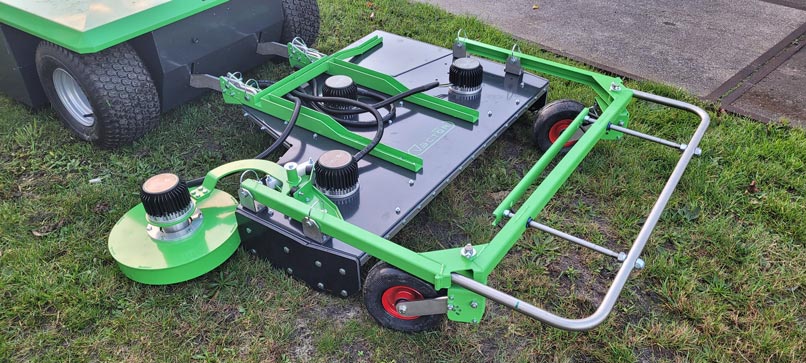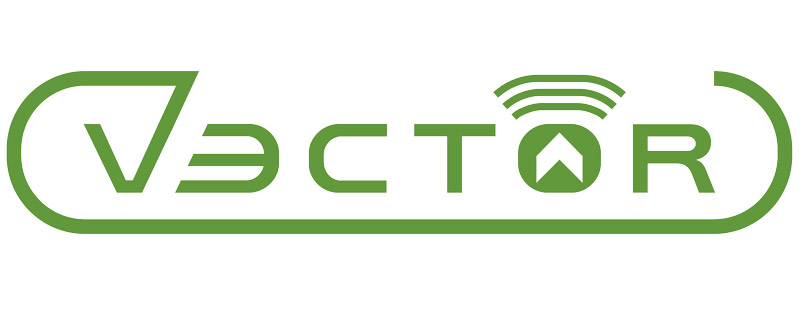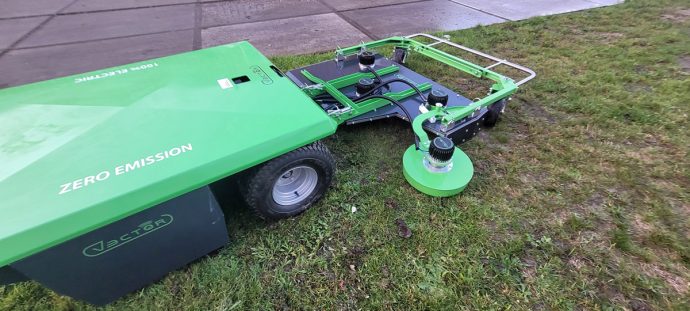How does a post mower work on an autonomous tool carrier?
A pole mower on an autonomous tool carrier works on the basis of various sensors and actuators that communicate with each other to enable the mowing of poles.
The tool carrier is equipped with a GPS system and a map of the terrain on which the posts are located. This enables the machine to determine its position and recognize the locations of the posts.
The post mower is equipped with a specially designed cutting device to mow the posts and a LIDAR (sensor) to detect the position of the posts. The sensor transmits information to the control unit of the tool carrier, which controls the machine to mow the posts correctly. This makes the post mower ideal for to mow solar parks autonomously.
The autonomous tool carrier also has a number of safety features to prevent accidents, such as sensors that detect obstacles and an automatic stop mechanism that stops the machine in the event of danger.
All these parts: the tool carrier with GPS, Lidar, sensors and cutting roof, work together to create an autonomous pole mower that is able to mow poles efficiently and safely.
For which applications is a pole mower interesting?
An (autonomous) post mower can be interesting for various applications, such as:
Farming: Farmers can use pole mowers to clear weeds around poles and other obstacles in their fields. This can improve the efficiency of the farming process and increase crop yields.
Public spaces: autonomous post mowers can be used to maintain parks, public gardens and other public spaces. They can be used to remove weeds around posts, trees and other obstacles to improve the maintenance of these areas.

Road construction: Post mowers can also be used to maintain verges along roads. They can be used to remove weeds around posts and other obstacles and thus improve the safety of road users.
Industry: autonomous pole mowers can be used in industry to facilitate the maintenance of wind turbines and solar panels, for example. Mowing the weeds around the posts makes access to these installations easier and safer.
Info post mower: (product name: O255)
| MOWING SYSTEM | |
| Blade type | Mulch knife |
| Mow distance | 1-2cm to obstacle |
| cutting width | 25,5 cm |
| MACHINE | |
| Type of machine | Attachment |
| Weight | 8,5 kg |
| Rotation | Flexible swivel arm |
Features obstacle mower or pole mower with an autonomous tool carrier?
An obstacle mower or post mower is a type of lawn mower specially designed to work in areas with many obstacles, such as trees, shrubs, posts at solar parks and flower beds. Here are some features of the post mower specially developed for the Vector WD2.0 autonomous tool carrier:
Maneuverability: An obstacle mower is very manoeuvrable and can easily maneuver around obstacles such as posts. It can also change direction quickly and is therefore ideal for mowing complex areas.
Smaller size: Post mowers are usually smaller in size than other lawn mowers. This makes it easier to maneuver them in tight spaces and restricted access areas.
cutting width: Obstacle mowers generally have a smaller cutting width than traditional lawn mowers. This is because they are designed to maneuver in narrow paths.
Special blade configurations: An obstacle mower may have special blade configurations to better mow around obstacles. For example, some obstacle mowers have caster wheels that tilt the blade at an angle for a better cut.
Protection from obstacles: Post mowers often have protective parts around the blade to prevent obstacles such as trees and shrubs from being damaged during mowing.
Safety: Obstacle mowers are often equipped with various safety features, such as an emergency stop button and a dead man's switch, to ensure operator safety while operating the machine.
In general, an obstacle mower or post mower is an agile and compact machine specially designed to work in complex areas with many obstacles, such as mowing the lawn around all poles under the solar panels on solar parks.

